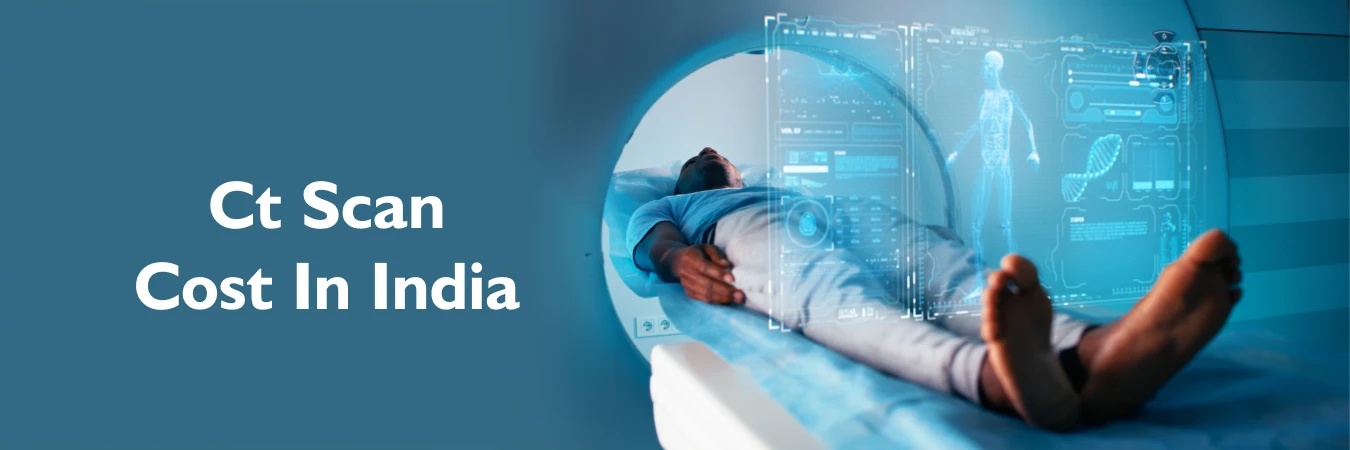- Cardiology 84
- Dermatology 45
- Endocrinology 33
- ENT 16
- Fertility 190
- Gastroenterology 78
- General-Medicine 81
- Gynecology 80
- Hematology 19
- Infectious-Diseases 33
- Neurology 52
- Oncology 34
- Ophthalmology 23
- Orthopedics 69
- Pediatrics 31
- Procedure 23
- Public-Health 144
- Pulmonology 59
- Radiology 8
- Urology 68
- Wellness 161
- Woman-and-child 77

CT Scan Cost In India
The cost of a CT scan in India depends on various factors, including the location, the body part being scanned, the contrasts being used, and the number of slice sections.
CT scan stands for Computerized Tomography, also known as CAT scan, which stands for Computerized Axial Tomography. It is a diagnostic investigation in radiology that uses X-rays and a computer to create cross-sectional pictures of the body.
A CT scan is a quick and painless procedure that provides more detailed pictures than a regular X-Ray. It can diagnose various conditions related to different parts of the body, including bones, organs, blood vessels and soft tissues. Usually, a CT scan is prescribed to visualize.
How Does a CT Scan Works?
- A CT scan machine is a large, tunnel-like structure with a table that slowly moves through it. To start the scan, the person is asked to lie on the table.
- As the table slowly moves into the CT machine, a scanner inside the machine rotates around the body and takes a series of X-rays from different angles.
- When one rotation of the scanner is completed, it means one full slice is completed and the image gets stored in the computer.
- The rotation of the X-ray scanner then repeats to produce another image slice.
- Thus, the process is continued until the desired number of image slices are collected, up to 256 slices.
- These collected image slices can be either displayed individually or stacked together in order to generate a 3-D image of the patient by the computer that stores the images during the scan.
- The individual image slices or the 3-D image of the body, makes the doctor’s job easier to spot the exact location of the problem.
Secure your health with a second opinion. Make informed decisions and book your appointment today!
Get A Second OpinionCT Scan Procedure
A CT scan is a day-care procedure that doesn't require hospitalization. Here's what to expect:
- Preparation : Patients are instructed to fast and consume only liquids before the scan. They wear a hospital gown and remove all jewelry and metal fastenings.
- During the Scan :
- Patients lie on a motorized table that moves into the CT machine.
- They may be repositioned as needed (face up, down, or sideways).
- Communication with the radiologist is via intercom for instructions.
- Remaining still is crucial to avoid blurring the images.
- Completion : The scan continues until the desired number of image slices, prescribed by the doctor, are obtained.
Why is a CT Scan Prescribed?
Doctors prescribe a CT scan to:
- Diagnose Bone and Joint Disorders : Detect complex fractures, tumors, and other bone abnormalities.
- Guide Treatments : Aid in procedures such as biopsies, radiation therapy, or surgery.
- Evaluate Internal Injuries : Assess trauma-related internal injuries or bleeding.
- Locate Conditions : Pinpoint the location of infections, tumors, or blood clots, including cancer.
- Monitor Treatment : Track the effectiveness of treatments for conditions like cancer and heart disease.
Ready to take control of your health journey? Book your appointment now and start your path towards wellness today!
Book an AppointmentCT Scan Cost in Hyderabad (Approx)
| Scan Type | Cost Details |
| CT Brain | Rs. 4004/- |
| CT Chest | Rs. 5720/- |
| CT Abdomen | Rs. 7150/- |
| CT Spine | Rs. 9295/- |
| CT Angiography | Rs. 15005/- |
Frequently Asked Questions
Factors affecting the cost include the type of CT scan (e.g., brain, chest, abdomen), the use of contrast dye, the hospital or diagnostic center's reputation, and the city or region where the scan is performed.
Additional costs may include consultation fees with a specialist, the cost of contrast dye if used, and any follow-up tests or procedures recommended based on the CT scan results.
You will lie on a table that travels through a circular scanner during a CT scan. The procedure is painless and typically takes 10 to 30 minutes. If a contrast dye is used, it may be injected into a vein or taken orally.
Radiation exposure during a CT scan is minimal, which is generally considered safe. However, repeated exposure should be minimized. There may also be risks related to the use of contrast dye, such as allergic reactions or kidney issues.
For most CT scans, you can eat and drink as usual. However, if contrast dye is used, you may be asked to fast for a few hours before the procedure. Follow your doctor's specific instructions.

- Cardiology 2132
- Dermatology 168
- Endocrinology 135
- ENT 97
- Fertility 217
- Gastroenterology 232
- General 478
- General-Medicine 1685
- Gynecology 169
- Hematology 85
- Infectious-Diseases 208
- Neurology 207
- Oncology 345
- Ophthalmology 65
- Orthopedics 187
- Pediatrics 83
- Procedure 72
- Public-Health 209
- Pulmonology 126
- Radiology 13
- Second Opinion 311
- Urology 294
- Wellness 600
- Woman-and-child 447
- Others 10217
Related Blogs
If you have any questions, please fill out the enquiry form or call us, and we will get back to you promptly.
040-68334455